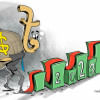Risk management challenges that our banks face

Risk is the variability of return—it can be both positive and negative. Risk management is concerned with reducing earnings volatility and avoiding losses, especially large ones. It is a process of identifying potential risks, quantifying them and then developing strategies to manage them.
Risk can be treated by one of the four options: risk avoidance, risk reduction, risk acceptance, and risk transfer. After that, risk management strategies are developed to be implemented, following which their effectiveness is evaluated. Banks face many risks that have differential effects on their performances. Banks have to manage these risks in order to maximise their profits initially and wealth ultimately. This year, banks in Bangladesh are going to face the following risks that they must address carefully.
The first kind of risk is credit risk, which occurs when the promised cash flows from loans held by banks may not be paid in full. It is also known as default risk, non-performing risk or counterparty risk. This risk gives birth to non-performing loans (NPLs). Banks in Bangladesh have been facing credit risk profoundly for a long time; our NPLs are very high compared to the international benchmark.
In the changing economic conditions, managing credit risk is the greatest challenge for the banking sector. In Bangladesh, 86 percent of financial assets are owned by banks. Our economic growth is heavily dependent on bank finance, and vice versa. Better performance of an economy is reflected in bank performance as well, because in such a condition, bank borrowers can invest their loans productively and repay the same on time. If an economy declines, it must be reflected through low profitability and high NPLs. The low potential of our economic growth, as projected by the International Monetary Fund (IMF) and the World Bank, must affect the performance of loans. Thus, banks must extend loans to creditworthy borrowers, although selecting such borrowers is always critical for banks. Still, they must engage their best efforts so that they can find as many right borrowers as possible. After the loans are sanctioned, they should be monitored properly as well.
Next comes interest rate risk, which happens when unexpected fluctuations in interest rates decline the value of assets. Interest rate risk can be related to reinvestment as well as reborrowing. The reinvestment risk arises when returns on funds to be reinvested fall below the cost of funds. The reborrowing risk, also known as refinance risk, happens when the cost of reborrowing funds rises above the returns being earned on investments.
The rise of interest rates has a negative effect on banks' profitability. It may increase interest expense and reduce interest income, generating low profits. Profit reduction is a hindrance to capital accumulation. In order to enhance capital, it is necessary to increase profit continuously. Rise in the interest rate also lowers the value of assets since there is a negative relationship between the interest rate and value of assets. Increase in the interest rate reduces the amount of capital as well, because any loss in the value of assets is adjusted with capital.
Banks are already facing interest rate risk as the caps on the rates were lifted and they are now determined by the market mechanism—the interaction between demand and supply. Earlier, banks could collect deposits at the maximum of six percent interest rate, while their lending rate did not exceed nine percent. The latest monetary policy stance, which increased the policy (repo) rate by 25 basis points, will further increase the cost of borrowing from Bangladesh Bank (BB). Both banks and their borrowers will find loans more expensive. Banks must offer high interest rates to attract deposits. Simultaneously, bank borrowers will have to pay high interest rates on loans and advances.
A rise in deposit rates will encourage people to save more, creating more inflow of funds in the banks. In contrast, a rise in the cost of borrowing will certainly reduce demand for loans. With increased cost of funds, bank borrowers may find it difficult to make their investment profitable, increasing the probability of default. If banks fail to lend their funds to the extent required, it will increase their opportunity cost—cost of keeping funds, having failed to lend them.
The third risk facing the banks is liquidity risk. A sudden surge in liability withdrawals may leave banks in a position of having to liquidate assets at very short notice and low prices. Liquidity risk generally arises from maturity mismatch between assets and liabilities. Banks in Bangladesh often face liquidity crises due to mismanagement of funds because they fail to forecast how much liquid assets they may need for a period. However, the recent liquidity problem in five Islamic banks has originated from a sudden outflow of funds that were not offset by the inflow. The BB lent them continuously to ease up their liquidity constraints. The central bank should look into the real problems of these banks so that their liquidity problem may be minimised. The overall banking sector must also be prudent in fund management to avoid abnormal liquidity problems.
Banks also need to be concerned with inflation risk, which happens due to a rise in price level. This risk reduces the amount of real income of banks. Inflation eats up the purchasing power of money because the real interest rate is calculated by subtracting inflation from nominal interest rate. In order to get real return from an investment, inflation must be lower than nominal interest rate. If there is no considerable positive gap between nominal interest rate and inflation, depositors find it less attractive to keep their funds in banks. With high lending rates driven by rising inflation, banks will be facing challenges to find borrowers in order to maintain the expected portfolios of investment. If inflation cannot be brought down as projected in the latest monetary policy stance, the increased policy rate may fail to bring the likely result in the banking sector.
With volatile foreign currency markets, banks will have to deal with foreign exchange risk too. This risk occurs when changes in exchange rates affect the value of a bank's assets and liabilities. In a floating exchange rate regime, where prices of foreign currencies are determined by market mechanism, there must be a trade-off between the demand for and supply of foreign currencies. Banks have to facilitate international trade and other services by supplying foreign currencies. They must have stable sources of foreign currencies. If the demand for a foreign currency exceeds its supply, its price will appreciate, leading banks to unexpected losses in foreign currency business. Recent experience shows many banks incurring catastrophic losses due to abnormal appreciation of the US dollar. The BB had to sell the dollar in the market to rescue these banks from dollar crises. The central bank itself also faced the problem of foreign currency reserves.
Banks will have to deal with the price risk as well, which arises from the declining value of an investment. Banks invest in stock markets to generate profits by diversifying their portfolios. But our stock markets are not guided by rational propositions and company fundamentals. These markets have huge information asymmetry—prices do not reflect performance. When banks invest in such markets, they assume enormous risk. Such participation in stock markets might bring abnormal losses to banks, so banks must be cautious before investing their depositors' funds.
Dr Md Main Uddin is professor and former chairman of the Department of Banking and Insurance at the University of Dhaka. He can be reached at [email protected]
Views expressed in this article are the author's own.
Follow The Daily Star Opinion on Facebook for the latest opinions, commentaries and analyses by experts and professionals. To contribute your article or letter to The Daily Star Opinion, see our guidelines for submission.

 For all latest news, follow The Daily Star's Google News channel.
For all latest news, follow The Daily Star's Google News channel. 











Comments